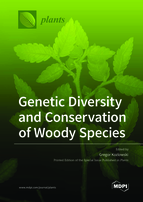Genetic Diversity and Conservation of Woody Species
A special issue of Plants (ISSN 2223-7747). This special issue belongs to the section "Plant Ecology".
Deadline for manuscript submissions: closed (30 June 2021) | Viewed by 34047
Special Issue Editor
2. Shanghai Chenshan Plant Science Research Center, Shanghai Chenshan Botanical Garden, Chinese Academy of Sciences, Shanghai 201602, China
Interests: arctic–alpine disjunctions; conservation biology; biogeography; biodiversity; dendrology; relicts; endemics; threatened species; phylogenetics; phylogeography
Special Issues, Collections and Topics in MDPI journals
Special Issue Information
Dear Colleagues,
Trees and other woody plants, such as shrubs and lianas, form the principal components in forests and many other ecosystems on our planet. Being among the largest and longest-living organisms, they support an immense share of the Earth’s terrestrial biodiversity, providing food and habitats for innumerable microorganisms, epiphytes, invertebrate, and vertebrate species. Woody species are perfect study objects, giving us a link between the past, present, and future. Woody species have also accompanied our own species throughout its evolution. Even today, billions of people depend on trees and shrubs for fuel, medicine, food, tools, fodder for livestock, shade, and watershed maintenance. Woody species therefore have a high scientific, economic, social, cultural, and aesthetic value.
However, the future of many trees and shrubs is uncertain. Ten of thousands of species are threatened by overharvesting, non-native pests and diseases, changes in accelerated land use, and climate warming. Many aspects of their biology, ecology, and biogeography are still unexplored or insufficiently understood. These knowledge shortfalls, concerning their genetic diversity, for example, significantly hinder the development of protection strategies and the elaboration of efficient action plans. This Issue, dedicated to this very diverse group of plants, aims to encourage on-going research and conservation efforts worldwide.
For this Special Issue of Plants, we therefore warmly welcome contributions (original research papers, reviews, perspectives, and opinions) on woody species and their conservation, from different fields of research, such as molecular biology, conservation biology, ecology, biogeography, and physiology.
Prof. Dr. Gregor Kozlowski
Guest Editor
Manuscript Submission Information
Manuscripts should be submitted online at www.mdpi.com by registering and logging in to this website. Once you are registered, click here to go to the submission form. Manuscripts can be submitted until the deadline. All submissions that pass pre-check are peer-reviewed. Accepted papers will be published continuously in the journal (as soon as accepted) and will be listed together on the special issue website. Research articles, review articles as well as short communications are invited. For planned papers, a title and short abstract (about 100 words) can be sent to the Editorial Office for announcement on this website.
Submitted manuscripts should not have been published previously, nor be under consideration for publication elsewhere (except conference proceedings papers). All manuscripts are thoroughly refereed through a single-blind peer-review process. A guide for authors and other relevant information for submission of manuscripts is available on the Instructions for Authors page. Plants is an international peer-reviewed open access semimonthly journal published by MDPI.
Please visit the Instructions for Authors page before submitting a manuscript. The Article Processing Charge (APC) for publication in this open access journal is 2700 CHF (Swiss Francs). Submitted papers should be well formatted and use good English. Authors may use MDPI's English editing service prior to publication or during author revisions.
Keywords
- woody species
- endangered woody species
- relict woody species
- phylogeography
- population genetics
- genomics
- landscape genetics
- dispersal biology
- seed ecology
- dendroecology
- dendroclimatology
- habitat fragmentation
- conservation biology
- conservation strategy
- conservation prioritizing
- in situ conservation
- ex situ conservation







